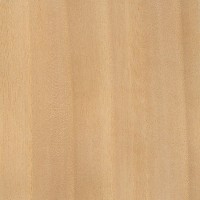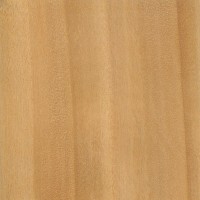 |
Common Name(s): White Willow Scientific Name: Salix alba Distribution: Europe and western and central Asia Tree Size: 65-100 ft (20-30 m) tall, 3-4 ft (1-1.2 m) trunk diameter Average Dried Weight: 25 lbs/ft3 (400 kg/m3) Specific Gravity (Basic, 12% MC): .34, .40 Janka Hardness: 570 lbf (2,530 N) Modulus of Rupture: 8,150 lbf/in2 (56.2 MPa) Elastic Modulus: 1,125,000 lbf/in2 (7.76 GPa) Crushing Strength: 3,900 lbf/in2 (26.9 MPa) Shrinkage: Radial: 4.2%, Tangential: 7.2%, Volumetric: 11.5%, T/R Ratio: 1.7 |
Color/Appearance: Heartwood is tan to pinkish brown. The sapwood is yellowish white, and is not always clearly or sharply demarcated from heartwood.
Grain/Texture: White Willow has a straight grain with a fine to medium uniform texture.
Endgrain: Semi-ring-porous (very subtle change in pore size from earlywood to latewood sometimes overlooked as diffuse-porous); medium to large pores in no specific arrangement, moderately numerous to numerous; commonly in radial multiples of 2-3; narrow rays not visible—sometimes even with the aid of hand lens, spacing normal to close; parenchyma banded (marginal).
Rot Resistance: Rated as non-durable to perishable, and also susceptible to insect attack.
Workability: With its low density, willow has poor machining characteristics, frequently resulting in fuzzy surfaces. Willow also tends to develop numerous drying defects and can be difficult to season. Glues and finishes well.
Odor: No characteristic odor.
Allergies/Toxicity: There have been very few adverse health effects associated with the actual wood of willow (Salix genus), however, the bark and other parts of the tree have been reported as sensitizers. Usually most common reactions simply include skin and respiratory irritation. See the articles Wood Allergies and Toxicity and Wood Dust Safety for more information.
Pricing/Availability: White Willow isn’t seen for sale in the United States because other domestic species, (such as Black Willow), are more readily available. Prices within its natural range are likely to be moderate.
Sustainability: This wood species is not listed in the CITES Appendices or on the IUCN Red List of Threatened Species.
Common Uses: Baskets, utility wood, crates, furniture, cricket bats, carvings, and other small specialty wood items.
Comments: White Willow is so named because the undersides of the leaves are a pale white. Historically, it’s been the wood of choice for cricket bats. Willow is a lightweight hardwood with good shock resistance, but overall is weak for its weight.
None available.
Scans/Pictures: There are currently no pictures of this exact wood species, but a similar species within the Salix genus is being substituted (S. nigra). If you’d like to contribute a wood sample of this specific species to be scanned, (even small pieces of veneer can be sent), please use the contact form.






I acquired this wood from a coworker, was said it might be willow. I have used it to make a stool so far, and look forward to making more stuff with it. I was hoping you could help identify and confirm/deny this. Thank you in advance.
I can’t make out enough endgrain detail as-is. Can you get a portion of the grain finely sanded and take a close up picture?
This is the sanded ‘cookie’ of the stool before any finish.
I guess I can’t rule out willow based on that endgrain. (Though I can’t say for sure on positive ID.) If the person that said it’s willow saw the standing tree, then I’d be inclined to trust their ID.
Hi, do you know where this data originally comes from? I would like to cite it in my research so it would be great to know some details about its origins.
Are you referring to the mechanical data? If so, this website shows and average from a variety of different sources, so no single source will usually match what’s written here. Holzatlas by Rudi Wagenfuhr and Timber in Austrlia by Keith Bootle both have entries on this wood, though there are other sources as well.
thanks Eric
Hello
I have a sample of timber which I think may be white willow. Here are some pix. The tree grew near Edinburgh, Scotland. Can you tell me what the timber is please? If you would like a sample I would be happy to send it to you.
Sorry, I can’t see the grain clearly enough to get a clear view of the endgrain. The wood surface still appears too rough. It’s also very hard to tell willow species from poplar species. Is white willow a fairly common species in your area?
Thanks for your reply. here is another pic of the endgrain, sliced more thinly. Still not very good but if you zoom in you can see the pores.
The tree was recently felled when we found it. From the twigs we have identified it as a willow, just not sure which. Willows are fairly common here, but I don’t know which species.
I’m afraid I don’t know of a way to ID willow down to a species level using anatomical features alone. Sorry.
English willow cricket bats. Most of the willow comes from England regardless of where the bat was made. The same species was also planted in Kashmir but despite there being not technical difference, Kashmir willow bats sell for considerably cheaper. The average bat has 8-12 grains across; fewer (4-6) make it easier to break-in but it doesn’t last for very long. More than 12 grains and the bat will need a long time to break in but would last longer. At competition level, minor imperfections in grain (as in 1st picture) are not acceptable (to players) despite many champions declaring… Read more »
Here’s a photo of a willow harp soundbox in construction.
Willow, black and white, is the traditional timber for the soundbox of the Celtic wire strung harp. The Trinity College Harp is said to have a willow soundbox, and Scotland’s Queen Mary Harp ‘s soundbox has been identified as willow.
Traditional/Ethnobotanical uses
The medicinal use of willow dates back 6,000 years. Ancient civilizations used willow tree extracts to treat pain, inflammation, and musculoskeletal conditions.
General uses
Willow bark can be an effective pain reliever if the salicylate content is adequate. Anticancer, antioxidant, and anti-inflammatory activity has been documented in limited trials. Clinical trials have shown that willow has moderate efficacy in treating lower back pain but very little efficacy in treating arthritic conditions.
Source :[ https://www.drugs.com/npc/willow-bark.html ]
Willow was & is the preferred material for charcoal in gunpowder manufacturing (Black Powder )